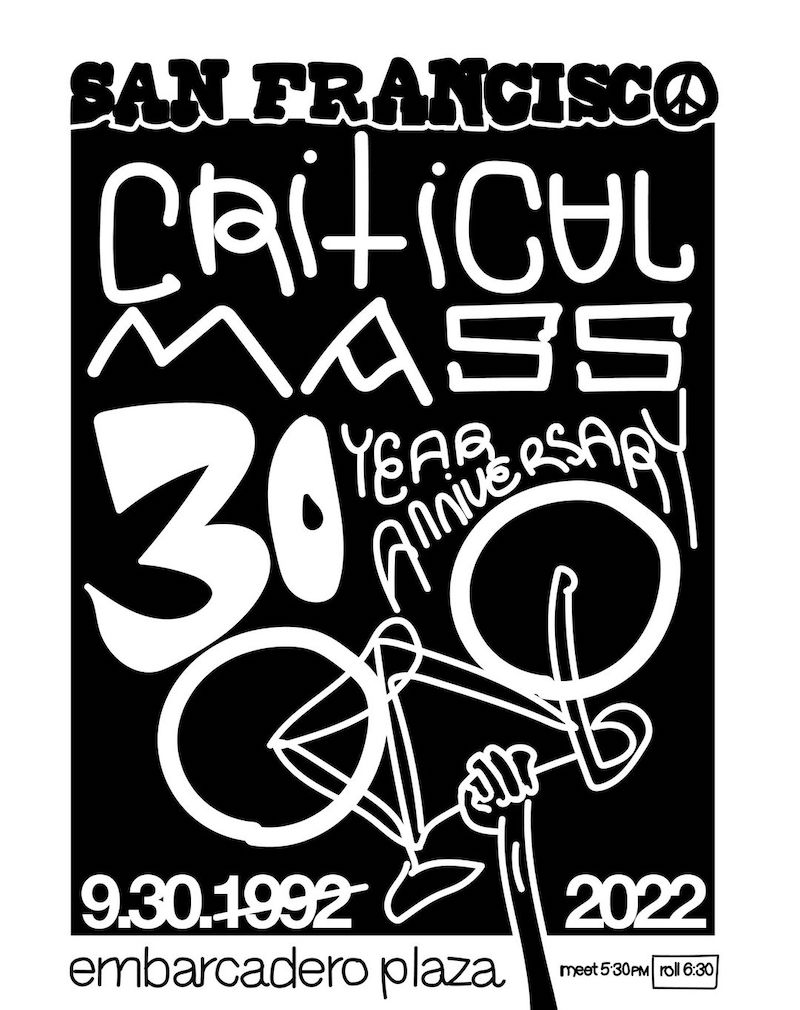
San Francisco Critical Mass celebrates 30 years of urban cycling this month. See you at the Embarcadero (formerly Justin Herman) plaza this Friday, September 30th.
Critical Mass is a mass bicycle ride that takes place on the last Friday of each month in cities around the world. Everyone is invited! No one is in charge! Bring your bike!
Next San Francisco Critical Mass: January 30th, 2026, 5:30pm, at Embarcadero Plaza (foot of Market Street).

San Francisco Critical Mass celebrates 30 years of urban cycling this month. See you at the Embarcadero (formerly Justin Herman) plaza this Friday, September 30th.
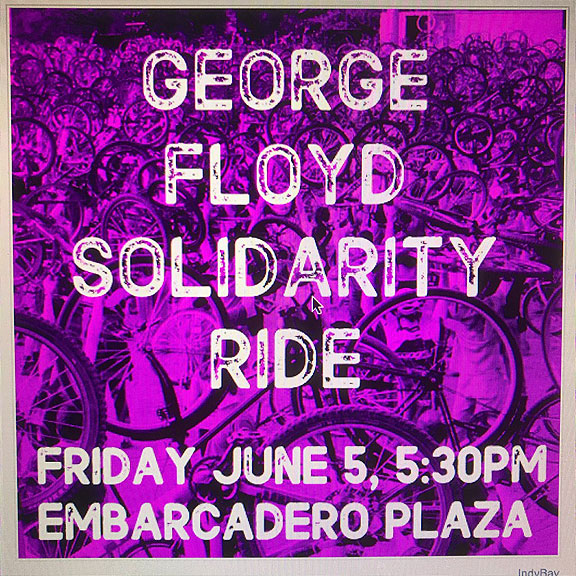
I was pinged multiple times in the two days prior to Friday and several friends wrote me, asking if I was going to go… I haven’t been to Critical Mass in San Francisco for about a year, and only went intermittently in the few years before that… it has long ago lost its purpose, its joy, and its function as place to meet, discuss, and imagine a better world.
So I wasn’t expecting more than maybe 150-250 people to show up for this, on the first Friday (as opposed to the longstanding tradition of riding only on Last Fridays). By the time I got there, about 6 pm, the ride was already rolling and it was a sight to behold! Thousands of cyclists were pouring up Market Street, many adorned with the ubiquitous homemade signage of the past weeks of protest. I was SO happy! I couldn’t believe my eyes! I rode and weaved among the cyclists, finding friends, and just enjoying the happy knowledge that A) San Franciscans are all out in solidarity these days; and B) Doing a Critical Mass-style ride is deeply in our cultural DNA. So here’s some shots I took.
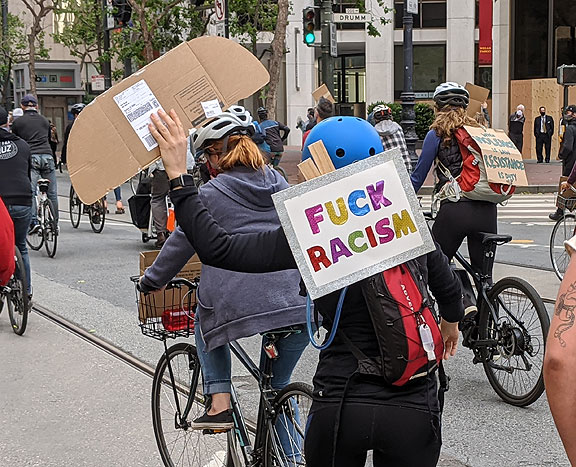
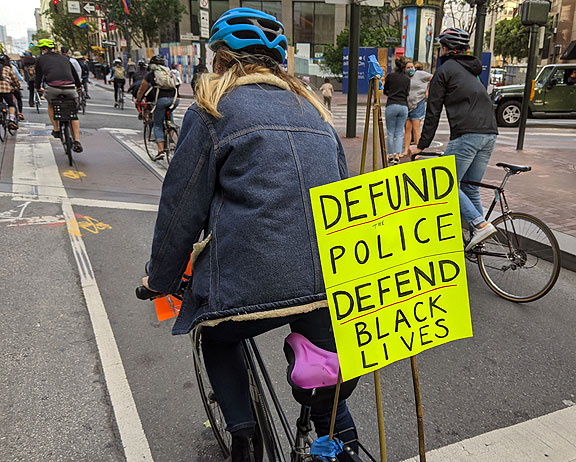
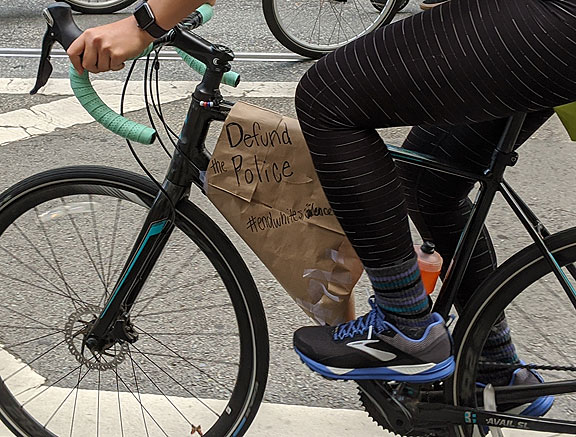
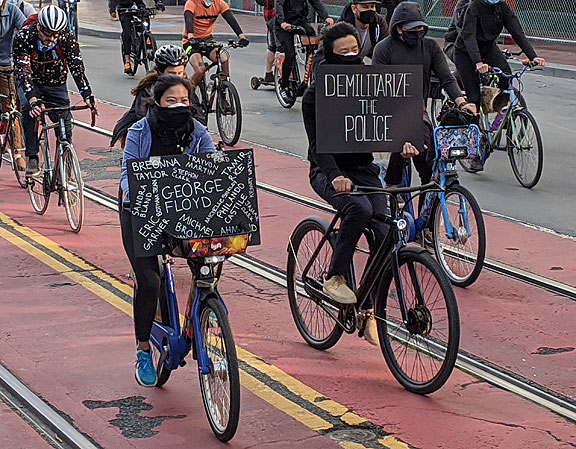
One of my first political experiences was attending the San Quentin Six trial back in 1975 in Marin County, and during that period I became aware of the Law Enforcement Assistance Administration (LEAA), a federal agency started under Nixon to standardize police practices nationally and to promote the use of surplus military equipment, a process that has radically expanded in the following decades.
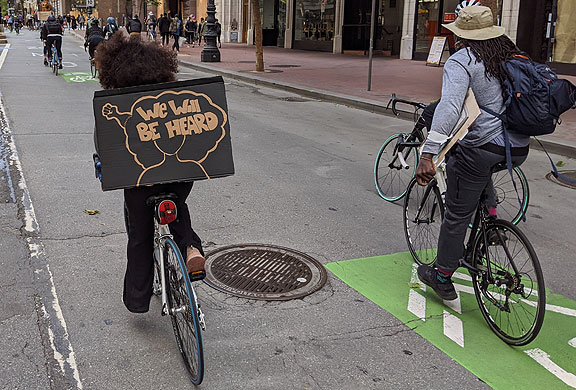
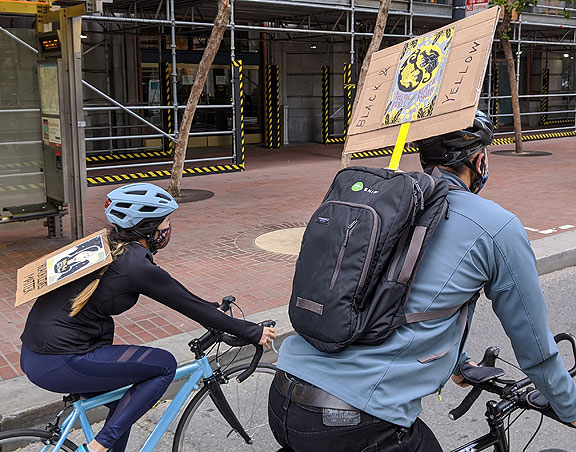
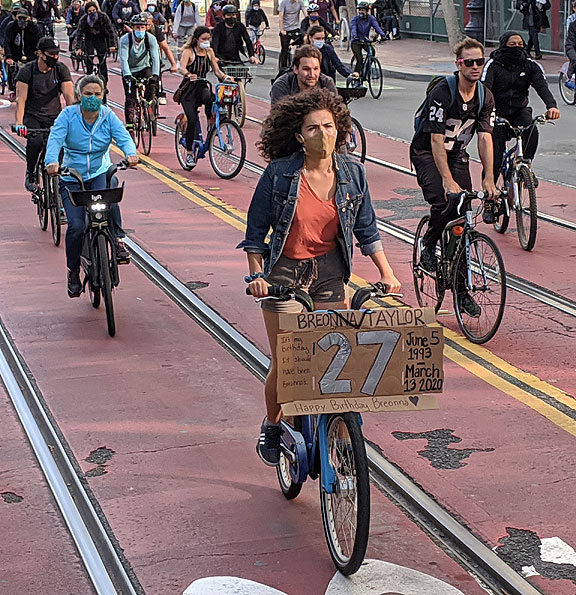
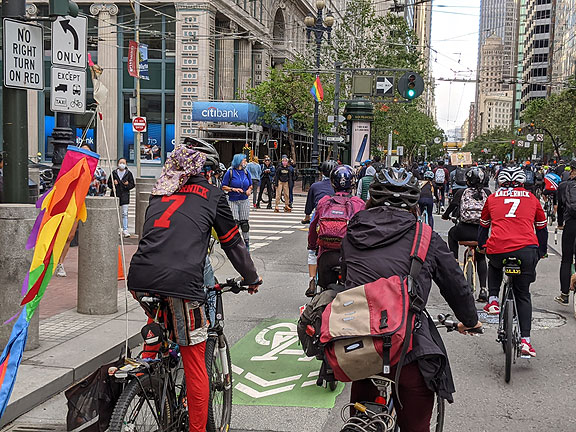
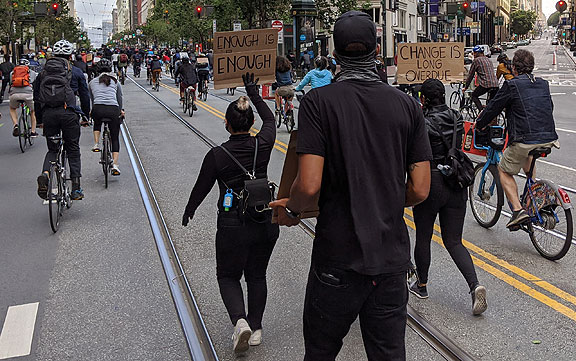
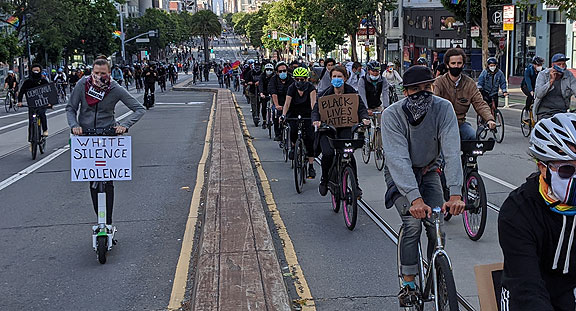
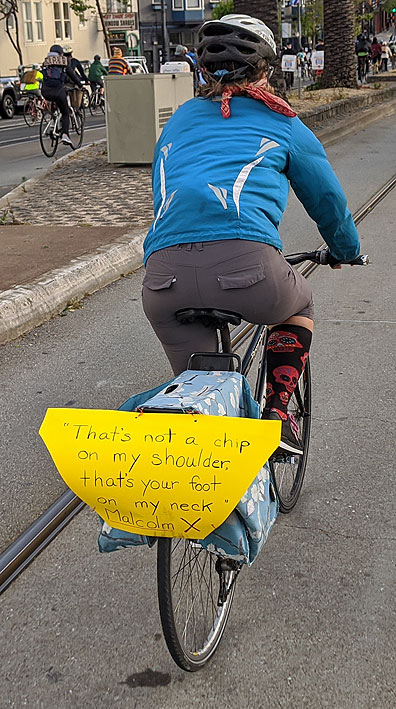
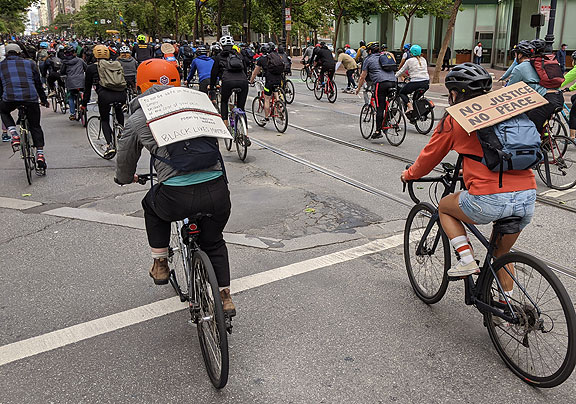
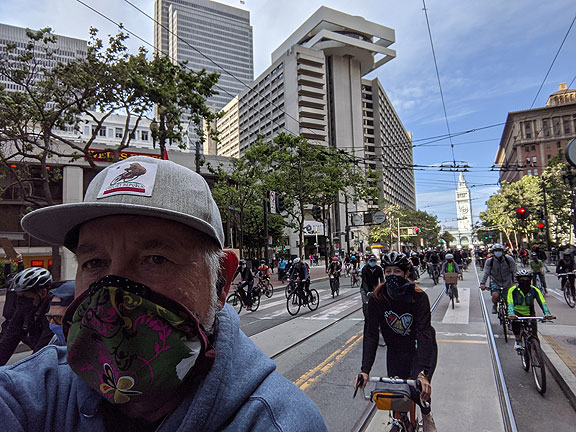
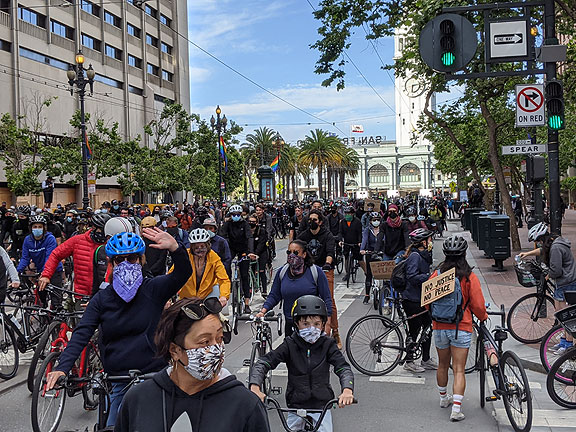
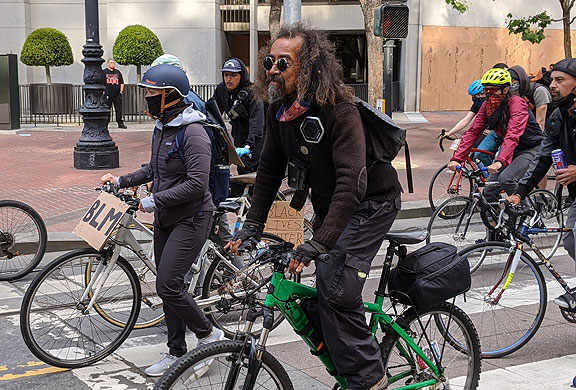
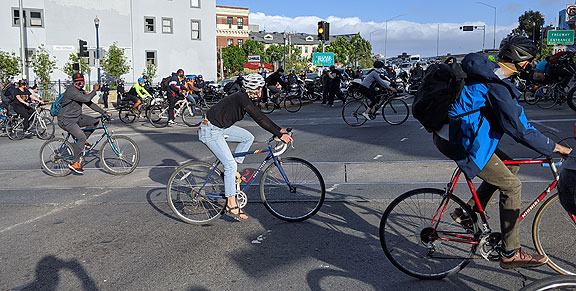
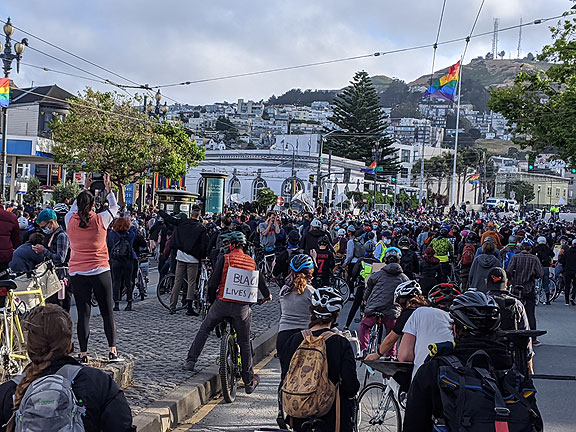
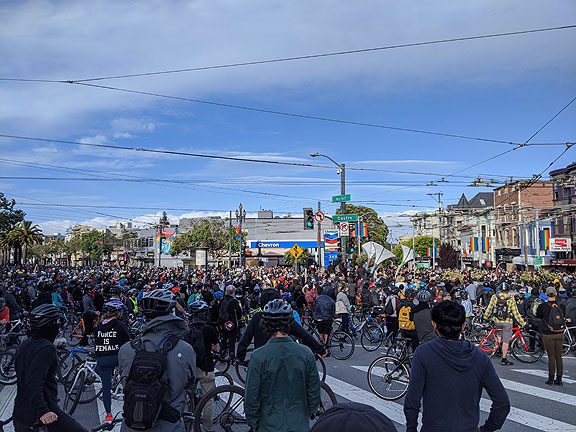
Maybe Critical Mass as a monthly event has passed its time (not such a big deal, after 28 years!)… but it’s great that the tactic was on the shelf ready to be embraced by thousands of San Franciscans who know how to do it!
Tags: #blacklivesmatter, #criticalmass, #sanfrancisco, #solidarity
Dozens of European cities have a long legacy of cycling for everyday transportation. Madrid is not one of these cities. But it IS one of the many European urban centers that has adopted the basic framework of Critical Mass, and the popularity of these rides—known to Madrileños as Bicicrítica—has propelled more riders through the town’s “gray breath of traffic” and into a dynamic building of bicycles AND bicycle culture. Through Elisabeth Lorenzi’s words—or Eli as we know her—we can see past the once solitary daily experience of cycling through Madrid she has experienced in her contribution to Shift Happens!: Critical Mass at 20 in “‘Alegria Entre Tus Piernas’: To Conquer Madrid’s Streets.”
Bicicrítica encompasses a great many perspectives, motivations, practices, and influences, and affinity with el movimiento de okupación (the squatting or Okupation Movement) is one of them. One of the greatest strengths of the Okupation Movement has been its role as an integrator of different citizen movements and initatives, including unique activist practices that were pioneered by Bicicrítica. Based on Critical Mass practices, do-it-yourself (DIY) bicycle workshops have emerged in autonomous and okupied spaces.
Bicicrítica, the best example of citizen mobilation, is not an isolated movement. It is a discourse and praxis connected to other movements and broader discourses, which has led to its rapid growth, since often the activists of related movements take the intitiative to promote Bicicrítica. But Critical Mass also embodies the desire for immediate and sustainable access to a better quality of life.
As the problem of mobility in cities—and the bicycle as a tool for improving this situation—becomes more important in the discourse and practices of many centros sociales okupados, they help sustain the growth and maintenance of bicycle-related actions. These DIY workshops, which are connected to each other through common initiatives related to bicycling in Madrid, in turn open a window on connections among social centers, other movements, and the general citizenry.
…
Bicicrítica offers an exceptional environment for socializing and empowerment around the bicycle, but it only happens once a month. The monthly gathering becomes a cultural stew where new initiatives and social opportunities emerge, whether for activism, pragmatic organizing, or pleasure. … But it has been the DIY workshop activists who have done the most to diffuse bicycling broadly and promote Bicicrítica, as they now offer weekly and daily activities related to the bicycle. The DIY bike workshops are housed in autonomous spaces, and when participating in them, visitors and activists merge urbanism, transit, political mobilization, and technological skill-sharing.
In 2009, I witnessed the emergence and development of eight DIY bicycle workshops. In general terms, these places offer support to bicyclists to fix or reinvent some aspect of their bike, construct a new one from loose parts, and facilitate the lending of rebuilt bicycles. Tools, recycled parts, and people with a passion for mechanics are the basic infrastructure of these workshops, where not only is it important to know about mechanics, but also to have personal initiative, creativity, and a cooperative spirit.
To learn a lot more about the interplay between Madrid’s social centers and Bicicrítica—and about the birth of the intergalactic Criticona—check out our newly added links page and pick up your copy of Shift Happens! today by ordering from us online. We return next time with more inspiring Critical Mass stories from Spain!!
In September 2012, to accompany the release of Shift Happens!: Critical Mass at 20, we published excerpts of Critical Mass history and its effects from several cities. We’re picking it back up again, because there is so much more to highlight (17 more towns and cities!), and also because book co-editors Chris Carlsson and LisaRuth Elliott will be appearing in a fun evening about the book at San Francisco’s Booksmith next week. On Friday, November 15, The Literary Foolery Cabaret will highlight Shift Happens! along with treating attendees to music, storytelling, and a unicycle duo! Check out the evening of “booze, books, bicycles, and burlesque” if you’re in the San Francisco Bay Area.
Today we showcase the most massive Critical Mass on the planet. Budapest boasts numbers of up to 80,000 bicyclists in their twice-a-year Critical Mass rides, active since 2004. Two articles — from Justin Hyatt and Kükü and the Critical Mass Budapest Community — chart the surprising rise (even to them) in popularity of the rides and the lasting effects on the city as well as on bicycling in general.
In “We Have Changed Our City Forever,” Kükü and the Critical Mass Budapest Community outline the beginnings of how “in less than five years a tiny subculture event blossomed into the largest civil movement in Hungary”:
The predecessor of Critical Mass Budapest was a regular ride organized by a group called Friends of Urban Cycling. It was much like the international Critical Mass, and ran for several years with 50-300 participants. At the same time the bike messenger community in Budapest often gathered for more hardcore rides, sometimes spontaneously or organized for special occasions.
However, the history of Critical Mass Budapest began only in 2004 when the mayor moved Carfree Day to the weekend in order to avoid interruption of car traffic. At that point some of us decided to organize a Critical Mass ride on this internationally-recognized September 22 date [of Carfree Day] as a protest. … Three weeks before the ride, approximately 30 messengers and their friends gathered at a park. … The idea was to recruit not merely participants, but organizers. “Critical Mass—The real Carfree Day,” read the slogan on the leaflets. We invited everyone for a huge demonstration hoping for 500 participants (that was the highest number we could imagine).
Justin Hyatt tells some more of the history of Critical Mass Budapest in “Positive Symbols and High Optimism in Budapest,” and how it has diverged from experiences in other cities:
The year that saw the axles greased and the tire rubber screeching en masse was the phenomenal year of 2004. An unheard of Critical Mass ride took place that numbered 4,000 people. … Every Spring and Fall season a new ride was organized. … 4,000 cyclists turned into 10,000 the following spring. That was doubled again in the fall to 20,000. … Eventually all the major and some minor towns in Hungary put on their own rides. Towns whose names you would never be able to pronounce and places hardly a speck on the map achieved ridership to rival the giants. … If numbers are a measure, the pinnacle of achievement in the history of Critical Mass Budapest was Earth Day in 2008 with 80,000 gleeful cyclists along for the ride. There has never been a larger ride that goes by the name of Critical Mass in the history of the world.
…
While holding firm to the notion that there must be something special to the spicy paprika that Hungarians eat, here are a few leading reasons:
First, it must be understood that these are rides that happen twice a year, not every month. There is therefore ample time to build up momentum and make a big splash of an event, something that would be a lot trickier were they held every month.
The rides are also registered ahead of time with the police and follow a given route, and thus hit a different note than the usual spontaneity and brazen independence of Critical Mass rides elsewhere.
The general consensus is that providing a legal basis for the movement has been an important compromise. … People rightly point to the fact that the average Hungarian is fearful of breaking the law or engaging in civil disobedience. Since the rides have been legal and also maintained a strict neutrality regarding party politics, the doors have been opened widely to the masses. It is a family event, an activist event, and an occasion where the citys head mayor or Ambassador of the Netherlands might just show up (and have, in fact).
Critical Mass has provided ordinary Budapest citizens with the opportunity to join a fun and dynamic movement that is free of the usual humdrum of everyday politics, and connect with others to take a stand for one very positive symbol: the bicycle. Many also quickly recognized a powerful message that is inherent in the Critical Mass rides: Ride your bike—it is cheap, it is fun, and it doesn’t pollute. Budapest has long been one of the most polluted cities in Europe.
Kükü and the Critical Mass Budapest Community talk a bit more about the impacts of and evolution beyond the rides:
In the early days we did not have any definite goal, but as time went on we realized that we are one of the most progressive communities in town and it would be a giant mistake not to engage in outlining our needs and standing up for our wishes. With our small community behind us we started to collect demands online, and took our neat little wish list to the City Hall. As the demonstrations grew bigger and bigger, the town began building some new bicycle lanes and the two-wheel symbol suddenly appeared in political campaigns. But political support was not strong enough and only resulted in 30-40 km of badly-designed and poorly-constructed bicycle roads, mostly at the expense of pedestrians. But we were too smart and enthusiastic to stop, so we reconsidered our goals and instead of politicians, we took aim at the people of Budapest. By this time a very strong net of cool activists started to take shape, and we have slowly become the largest civil movement in Budapest, without any official organization, strict hierarchy, office, or expenses.
…
The city cannot keep up with the bike boom and is now facing a strange phenomenon: as cyclists have no dedicated space, they have simply begun to flood the streets and ride anywhere they can. In the beginning this led to numerous conflicts with motorists, but soon it brought a drastic drop in accidents, which fell to about 10% of their previous level; this in turn caused a further decline of the fear that inhibits people from riding bikes in traffic. There’s something really unique going on in Budapest: the city is becoming bicycle-friendly despite the circumstances, without substantial investments.
…
We’ve moved past the never-ending growth as the agent of change. Now the everyday sense of enormous numbers of cyclists is the demonstration itself, spreading cycling like a virus to workplaces and schools. … The unbelievable truth is that we have managed to change our city forever.
To learn more about the various ways the Budapest bicycle movement has matured, and how cycling enthusiasm has reached out past the city to the world, get your own copy of Shift Happens!: Critical Mass at 20, either at the event next week, or online. You can also download it to your Kindle.